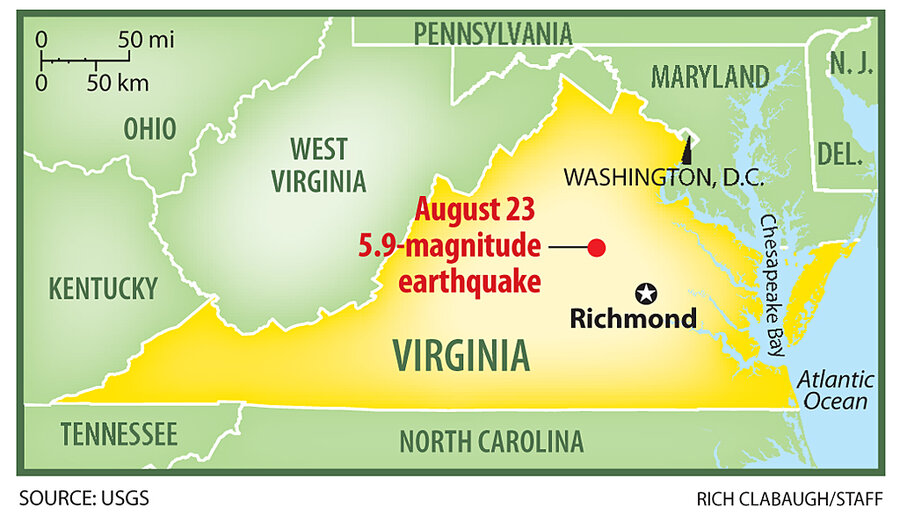East Coast earthquake: How does a 5.9 temblor happen in Virginia?
Loading...
As if tracking hurricane Irene isn't enough, the eastern seaboard was rocked by a magnitude 5.8 earthquake Tuesday afternoon.
The quake's epicenter sat about five miles southwest of the town of Mineral, Va., in the center of the state. The rupture occurred roughly 3.7 miles under the surface.
Shaking was felt as far west and north as Ohio and Massachusetts and as far south as North Carolina, according to initial shaking reports filed with the US Geological Survey.
According to USGS seismic hazard data, the area around epicenter of today's quake stands a 70 to 75 percent chance of experiencing a quake of at least magnitude 5 once every 1,000 years or so.
Strong quakes originating along the eastern seaboard are rare, but they happen.
- In 1755, a temblor struck off of Cape Ann, north of Boston, with a magnitude now estimated at 5.9.
- New York City registered a magnitude 5.5 earthquake in 1884.
- Charleston, S.C., experienced a 7.3 earthquake in 1886.
- In 1925, a magnitude 7 quake struck near La Malbaie, Quebec.
The quake was moderate, notes Andre Filiatraut, who heads the Multidisciplinary Center for Earthquake engineering research at the State University of New York at Buffalo. But "it is significant because we haven't had very many earthquakes of this magnitude occurring in the eastern United States or eastern Canada."
The relatively low frequency of moderate-to-strong earthquakes in the eastern US compared with shaking and volcanism along the the West Coast is due to significant differences in the the geological activity taking place beneath their residents' feet.
In California's case, the western edge of the state straddles an active boundary between two enormous plates in Earth's crust – the North American plate and the Pacific Plate. The San Andreas fault and its tributaries mark the boundary with plenty of shaking and mountain-building as the Pacific Plate grinds against its way north against the continent.
Why quakes happen on the East Coast
The eastern seaboard, by contrast, sits in the middle of the North American Plate, but 200 million to 300 million years ago it was along an ancient plate boundary that ran through a connected Europe, Africa, and North America.
Crustal collisions 300 million years ago formed the Appalachian Mountains, which would have grown as tall as today's Himalayas, explains Steven Jaumé, a geophysicist at the College of Charleston in South Carolina. Then, 200 million years ago, the continents began to split, forming the Atlantic Ocean.
Both the collisions and the splitting generated a network of faults under what is now the East Coast.
Over the intervening millenniums, the Appalachians eroded, providing the soil along the Piedmont that, at Charleston, is some 3,000 feet deep. Meanwhile, the crust cooled and became more rigid, locking the faults in place, but remaining generally inactive.
These faults, however, are still susceptible to stresses on the crust. Some of these stresses can come from the mid-Atlantic Ridge, a structure that looks like a zipper and runs north and south along the Atlantic Ocean floor. It is constantly oozing molten material from deep in the earth, forming fresh crust and pushing North America and Europe farther apart at the rate of about 17 millimeters a year.
As the new crust formed by the ridge pushes westward and eastward, it contributes stress to the ancient faults along the East Coast, explains Thomas Herring, a geophysicist at the Massachusetts Institute of Technology in Cambridge.
When that stress builds along a fault zone with the right orientation, "occasionally it might rupture," adds Chuck Bailey, a geology professor at the College of William and Mary in Williamsburg, Va. But, he adds, the fault zones most susceptible to occasional quakes are not uniformly spread throughout the eastern US. And they don't always manifest themselves in easy to spot features on the surface, the way faults do in the West.
Why it was felt so far away
Some of the quake activity, especially in the Northeast and into Canada, also can be traced to the melting of continental glaciers after the last Ice Age. Hudson Bay is rising about 2 centimeters a year – the crust rising in a process akin to releasing a squeezed ball. That also adds to the stresses on the crust.
Tuesday's quake was felt across a wide swath of the region because the rock formations deep beneath the surface are old and cold, and so transmit seismic waves more efficiently than thick layers of ancient sediment.
For easterners not used to thinking about earthquakes, Tuesday's shaking should serve as a reminder than quakes are more than theoretical occurrences, Dr. Bailey says.
The event also "may produce a focus of energy" on the part of researchers "to think about why we do get earthquakes in these regions that are far away from plate boundaries."





